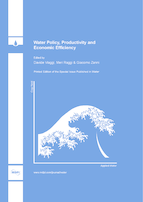Water Policy, Productivity and Economic Efficiency
A special issue of Water (ISSN 2073-4441). This special issue belongs to the section "Water Resources Management, Policy and Governance".
Deadline for manuscript submissions: closed (20 December 2013) | Viewed by 83152
Special Issue Editors
Interests: public goods; innovation; common agricultural policy; agriculture; water; bioeconomy
Special Issues, Collections and Topics in MDPI journals
Interests: sample theory; primary data collection; environmental impact assessment in particular referred to water resources; discrete choice model; monetary valuation of public goods (contingent valuation; choice experiments) principal-agent models; multivariate statistical methodologies
Special Issues, Collections and Topics in MDPI journals
Interests: agricultural economics; environmental impact assessment in agriculture; innovation in agriculture
Special Issues, Collections and Topics in MDPI journals
Special Issue Information
Dear Colleagues,
Most of the literature addresses water policy as an issue related to environmental conservation. However, water remains a major productive factor, particularly in agriculture. This role is made even more prominent in a context characterised by economic crises, increased competition across markets and climate change. It is also emphasised by the fossil energy limitations, which also highlights the water-energy nexus as a key resource issue for economic viability.
The change in needs not only requires a change in perspective, but also points at the need to study institutional innovations and economic evaluation instruments able to better assess policy performance and provide evidence for improvemed design.
This special issue aims to encourage debate and dialogue on water policy in this perspective, focusing on the future of water as a productive factor; in particular, high quality papers illustrating original research or comprehensive reviews are sought on the following issues:
- Economic analysis of experiences and open issues with innovative management of water for crop production.
- Production and efficiency effects of innovative policy instruments and mechanisms (water markets, auctions, pricing mechanisms).
- Ex-post and ex ante policy evaluation approaches, methods and tools, and their application to cost-benefit and cost-effectiveness analysis of water policy measures from the point of view of economic efficiency and productivity.
- Efficiency effects of coordination between water policy and specific sector policies (e.g. agriculture, energy).
- Water policy and viability of economic sectors in the context of drought and climate change.
- Water policy and wider economic and social issues (global economy, international markets, food security).
- Water policy and competitiveness.
Prof. Dr. Davide Viaggi
Dr. Meri Raggi
Prof. Dr. Giacomo Zanni
Guest Editors
Submission
Manuscripts should be submitted online at www.mdpi.com by registering and logging in to this website. Once you are registered, click here to go to the submission form. Manuscripts can be submitted until the deadline. Papers will be published continuously (as soon as accepted) and will be listed together on the special issue website. Research articles, review articles as well as communications are invited. For planned papers, a title and short abstract (about 100 words) can be sent to the Editorial Office for announcement on this website.
Submitted manuscripts should not have been published previously, nor be under consideration for publication elsewhere (except conference proceedings papers). All manuscripts are refereed through a peer-review process. A guide for authors and other relevant information for submission of manuscripts is available on the Instructions for Authors page. Water is an international peer-reviewed Open Access quarterly journal published by MDPI.
Please visit the Instructions for Authors page before submitting a manuscript. The top five best papers, chosen by editors based on the review reports, will be published free of charge. The Article Processing Charge (APC) for publication in this open access journal is 1000 CHF (Swiss Francs).
Keywords
- water policy design
- economic efficiency and productivity
- water markets
- climate change
- evaluation instruments
Related Special Issue
- Water Policy Collection in Water (48 articles)






